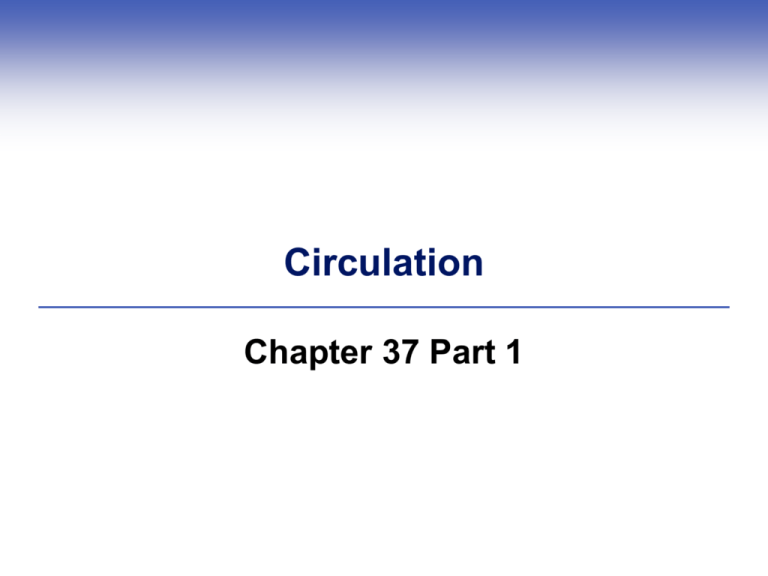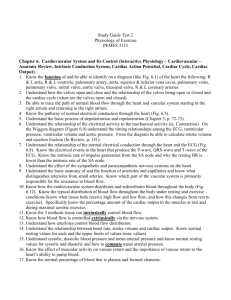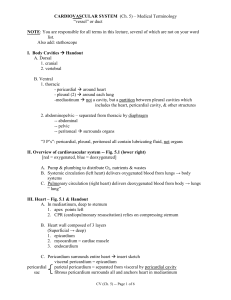Blood Cells - Del Mar College
advertisement

Circulation Chapter 37 Part 1 Impacts, Issues And Then My Heart Stood Still Each heartbeat starts with an electrical signal; in sudden cardiac arrest, a defibrillator is needed to restart the heart 37.1 The Nature of Blood Circulation A circulatory system distributes materials throughout the vertebrate body (and some invertebrates) A heart pumps the transport medium (blood) through vessels Blood and interstitial fluid (fluid between cells) make up the body’s internal environment Two Kinds of Circulatory Systems Open circulatory system (arthropods, mollusks) • Blood moves through hearts and large vessels, but also mixes with interstitial fluid Closed circulatory system (annelids, vertebrates) • Blood remains inside heart and blood vessels • Materials diffuse between blood and interstitial fluid at capillaries Open and Closed Circulatory Systems Fig. 37-2a, p. 638 aorta heart pump spaces or cavities in body tissues A In a grasshopper’s open system, a heart (not like yours) pumps blood through a vessel, a type of aorta. From there, blood moves into tissue spaces, mingles with interstitial fluid, then reenters the heart at openings in the heart wall. Fig. 37-2a, p. 638 Fig. 37-2b, p. 638 dorsal blood vessel pump largediameter blood vessels capillary bed (many small vessels that serve as a diffusion zone) large-diameter blood vessels two of five hearts ventral blood gut cavity vessels B The closed system of an earthworm confines blood inside pairs of muscular hearts near the head end and inside many blood vessels. Fig. 37-2b, p. 638 Animation: Types of circulatory systems Evolution of Circulation in Vertebrates Fishes • Heart with two chambers • Single circuit of circulation Amphibians • Heart with three chambers • Two partially separated circuits Birds and mammals • Heart with four chambers • Two fully separate circuits Circulation in Birds and Mammals The four-chambered heart has two separate halves, each with an atrium and a ventricle Each half pumps blood in a separate circuit • Pulmonary circuit: Blood flows from right half of heart, to lungs (gains oxygen), to left half of heart • Systemic circuit: Blood flows from left half of heart, to body (loses oxygen), to right half of heart Comparison of Flow Circuits Fig. 37-3a, p. 639 capillary beds of gills heart A In fishes, the heart has two chambers: one atrium and one ventricle. Blood flows through one circuit. It picks up oxygen in the capillary beds of the gills, and delivers it to capillary beds in all body tissues. Oxygen-poor blood then returns to the heart. rest of body Fig. 37-3a, p. 639 Fig. 37-3b, p. 639 lungs right atrium left atrium ventricle rest of body B In amphibians, the heart has three chambers: two atria and one ventricle. Blood flows along two partially separated circuits. The force of one contraction pumps blood from the heart to the lungs and back. The force of a second contraction pumps blood from the heart to all body tissues and back to the heart. Fig. 37-3b, p. 639 Fig. 37-3c, p. 639 lungs right atrium right ventricle left atrium left ventricle C In birds and mammals, the heart has four chambers: two atria and two ventricles. The blood flows through two fully separated circuits. In one circuit, blood flows from the heart to the lungs and back. In the second circuit, blood flows from the heart to all body tissues and back. rest of body Fig. 37-3c, p. 639 Fig. 37-3d, p. 639 lake river in river out 1 2 3 1 2 3 123 D Why flow slows in capillaries. Picture a volume of water in two fast rivers flowing into and out of a lake. The flow rate is constant, with an identical volume moving from points 1 to 3 in the same interval. However, flow velocity decreases in the lake. Why? The volume spreads out through a larger crosssectional area and flows forward a shorter distance during the specified interval. Fig. 37-3d, p. 639 Animation: Circulatory systems Animation: Flow velocity 37.1 Key Concepts Overview of Circulatory Systems Many animals have either an open or a closed circulatory system that transports substances to and from all body tissues All vertebrates have a closed circulatory system, in which blood is always contained within the heart or blood vessels 37.2 Characteristics of Blood Blood consists mainly of plasma, a protein-rich fluid that carries wastes, gases and nutrients Blood cells and platelets form in bone marrow and are transported in plasma • Platelets are fragments of megakaryocytes, active in clotting Blood Cells Red blood cells (erythrocytes) • Contain hemoglobin that carries oxygen from lungs to tissues • Quantified in cell count White blood cells (leukocytes) • Defend the body from pathogens • Neutrophils, basophils, eosinophils, monocytes, and lymphocytes (B and T cells) Components of Human Blood Components Amounts Main Functions Plasma Portion (50-60% of total blood volume) 1. Water 91-92% of total plasma volume 2. Plasma proteins (albumins, globulins, fibrinogen, etc. 7-8% 3. Ions, sugars, lipids, amino acids, hormones, vitamins, 1-2% dissolved gases, etc. Solvent Defense, clotting, lipid transport, extracellular fluid volume controls Nutrition, defense, respiration, extracellular fluid volume controls, cell communication, etc. Cellular Portion (40-50% of total blood volume; numbers per microliter) Oxygen, carbon 1. Red blood cells 4,600,000-5,400,000 dioxide transport to and from lungs 2. White blood cells: Neutophils Lymphoctyes Monocytes (macrophages) Eosinophils Basophils 3,000-6,750 1,000-2,700 150-720 100-380 25-90 Fast-acting phagocytosis Immune responses Phagocytosis Killing parasitic worms Anti-inflammatory secretions 3. Platelets 250,000-300,000 Red Roles in blood clotting blood cell White blood cell platelet Stepped Art Fig. 37-4, p. 640 Cellular Components of Human Blood stem cell in bone marrow myeloid stem cell red blood cell precursor granulocyte precursor lymphoid stem cell monocyte precursor megakaryocytes platelets red blood cells (erythrocytes) neutrophils basophils monocytes T lymphocytes eosinophils (immature (mature in phagocytes) thymus) B lymphocytes (mature in bone marrow) Fig. 37-5, p. 641 37.3 Hemostasis Hemostasis is a three-phase process that stops blood loss, constructs a framework for repairs • Damaged vessel constricts • Platelets accumulate • Cascading enzyme reactions involving plasma proteins cause clot formation Three-Phase Process of Hemostasis Stimulus A blood vessel is damaged. Phase 1 response A vascular spasm constricts the vessel. Phase 2 response Platelets stick together plugging the site. Phase 3 response Clot formation starts: 1. Enzyme cascade results in activation of Factor X. 2. Factor X converts prothrombin in plasma to thrombin 3. Thrombin converts fibrinogen, a plasma protein, to fibrin threads. 4. Fibrin forms a net that entangles cells and platelets, forming a clot. Stepped Art Fig. 37-6, p. 642 37.4 Blood Typing Blood type • Genetically determined differences in molecules on the surface of red blood cells Agglutination • Clumping of foreign cells by plasma proteins • When blood of incompatible types mixes, the immune system attacks the unfamiliar molecules Agglutination ABO Blood Typing Blood type O is a universal donor; blood type AB can receive blood from any donor Mixing ABO Blood Types O Blood Type of Donor A B AB Blood Type of Recipient O A B AB Fig. 37-8, p. 643 Animation: ABO compatibilities Rh Blood Typing An Rh- mother may develop Rh+ antibodies if blood from an Rh+ child enters her bloodstream during childbirth These antibodies may attack the red blood cells of the next Rh+ fetus Rh Complications of Pregnancy Rh+ Rh+ markers on the red blood cells of a fetus Rh– fetus A An Rh+ man and an Rh– woman carrying his Rh+ child. This is the mother’s fi rst Rh+ pregnancy, so she has no anti-Rh+ antibodies. But during birth, some of the child’s Rh+ cells get into her blood. Fig. 37-9a, p. 643 anti-Rh+ antibody molecules any subsequent Rh+ fetus B The foreign marker stimulates antibody formation. If this woman gets pregnant again and if her second fetus (or any other) carries the Rh+ protein, her anti-Rh+ antibodies may attack the fetal red blood cells. Fig. 37-9b, p. 643 Animation: Rh factor and pregnancy 37.2-37.4 Key Concepts Blood Composition and Function Vertebrate blood is a fluid connective tissue It consists of red blood cells, white blood cells, platelets, and plasma (the transport medium) Red blood cells function in gas exchange; white blood cells defend tissues, and platelets function in clotting 37.5 Human Cardiovascular System The term “cardiovascular” comes from the Greek kardia (for heart) and Latin vasculum (vessel) In a cardiovascular circuit, blood flows from the heart through arteries, arterioles, capillaries, venules, veins, and back to the heart Two Circuits of the Human Cardiovascular System Pulmonary circuit • Oxygen-poor blood flows from the heart, through a pair of lungs, then back to the heart • Blood takes up oxygen in the lungs Systemic circuit • Oxygenated blood flows from the heart (through the aorta) into capillary beds where it gives up O2 and takes up CO2, then flows back to the heart Pulmonary and Systemic Circuits of the Human Cardiovascular System Fig. 37-10a, p. 644 right pulmonary artery capillary bed of right lung pulmonary trunk left pulmonary artery capillary bed of left lung to systemic circuit from systemic circuit pulmonary veins A Pulmonary Circuit for Blood Flow heart Fig. 37-10a, p. 644 Fig. 37-10b, p. 644 (pulmonary vessels to and from thoracic cavity) capillary beds of head, upper extremities to pulmonary aorta circuit from pulmonary circuit heart (diaphragm, the muscular partition between thoracic and abdominal cavities) capillary beds of other organs in thoracic cavity capillary bed of liver capillary beds of intestines B Systemic Circuit for Blood Flow capillary beds of other abdominal organs and lower extremities Fig. 37-10b, p. 644 Animation: Human blood circulation Major Blood Vessels of the Human Cardiovascular System Jugular Veins Carotid Arteries Ascending Aorta Superior Vena Cava Pulmonary Arteries Pulmonary Veins Coronary Arteries Hepatic Vein Brachial Artery Renal Vein Renal Artery Inferior Vena Cava Abdominal Aorta Iliac Veins Iliac Arteries Femoral Vein Femoral Artery Fig. 37-11, p. 645 Animation: Major human blood vessels The Circulatory System and Homeostasis food, water intake oxygen intake Digestive System Respiratory System nutrients, water, salts oxygen elimination of carbon dioxide carbon dioxide Circulatory System Urinary System water, solutes elimination of food residues rapid transport to and from all living cells elimination of excess water, salts, wastes Fig. 37-12, p. 645 37.6 The Human Heart A sac of connective tissue (pericardium) surrounds the heart muscle (myocardium) Endothelium lines heart chambers and blood vessels Heart valves keep blood moving in one direction • AV valves separate atria and ventricles • Semilunar valves separate ventricles and arteries The Human Heart Fig. 37-13a, p. 646 superior vena cava (flow from head, arms) arch of aorta trunk of pulmonary arteries (to lungs) right semilunar valve (shown closed) to pulmonary trunk left semilunar valve (closed) to aorta right pulmonary veins (from lungs) left pulmonary veins (from lungs) right atrium left atrium right AV valve (opened) left AV valve (opened) right ventricle left ventricle (muscles that prevent valve from everting) endothelium and underlying connective tissue inferior vena cava (from trunk, legs) myocardium septum (partition between heart’s two halves) inner layer of pericardium heart’s apex Fig. 37-13a, p. 646 Fig. 37-13b, p. 646 right lung left lung 1 B The heart is located between the lungs in the thoracic cavity. 2 ribs 1–8 3 4 5 6 7 8 pericardium diaphragm Fig. 37-13b, p. 646 Fig. 37-13c, p. 646 C Outer appearance. Pads of fat on the heart’s surface are normal. Fig. 37-13c, p. 646 Animation: The human heart The Cardiac Cycle Cardiac cycle: Heart muscle alternates between diastole (relaxation) and systole (contraction) • • • • Blood collects in atria AV valves open, blood flows into ventricles Contraction of ventricles drives blood circulation Ventricles contract with a wringing motion from bottom to top The Cardiac Cycle A Atria fill. Fluid pressure opens the AV valves, blood flows into the ventricles. B Next, atria contract. As fluid pressure rises in the ventricles, AV valves close. D Ventricles relax. Semilunar valves close as atria begin filling for the next cardiac cycle. C Ventricles contract. Semilunar valves open. Blood flows into aorta and pulmonary artery. Fig. 37-14, p. 647 A Atria fill. Fluid pressure opens the AV valves, blood flows into the ventricles. B Next, atria contract. As fluid pressure rises in the ventricles, AV valves close. D Ventricles relax. Semilunar valves close as atria begin filling for the next cardiac cycle. C Ventricles contract. Semilunar valves open. Blood flows into aorta and pulmonary artery. Stepped Art Fig. 37-14, p. 647 Animation: Cardiac cycle Cardiac Muscle Cardiac muscle cells are striated (divided into sarcomeres) and have many mitochondria Cells attach end to end at intercalated discs Neighboring cells communicate through gap junctions that conduct waves of excitation Cardiac Muscle Cells and Gap Junctions intercalated disk a branching cardiac muscle cell (part of one cardiac muscle fiber) b Part of a gap junction across the plasma membrane of a cardiac muscle cell. The junctions connect cytoplasm of adjoining cells and allow electrical signals that stimulate contraction to spread swiftly between them. Fig. 37-15, p. 647 How the Heart Beats Cardiac pacemaker (SA node) • A clump of noncontracting cells in the right atrium’s wall spontaneously fires action potentials about 70 times per minute Cardiac conduction system • Signal spreads from SA node to AV node and junctional fibers in the septum, so heart contracts in a coordinated fashion The Cardiac Conduction System SA node (cardiac pacemaker) AV node (the only point of electrical contact between atria and ventricles) junctional fibers branchings of junctional fibers (carry electrical signals through the ventricles) Fig. 37-16, p. 647 Animation: Cardiac conduction 37.5-37.6 Key Concepts The Human Heart and Two Flow Circuits The four-chambered human heart pumps blood through two separate circuits of blood vessels One circuit extends through all body regions, the other through lung tissue only Both circuits loop back to the heart Animation: ABO blood group genetics Animation: Hemostasis Animation: Waller’s experiment Animation: White blood cells





